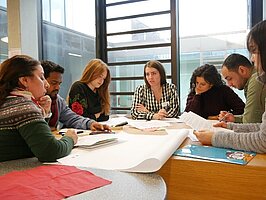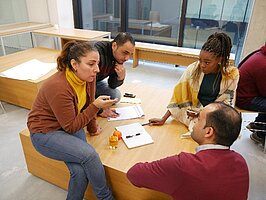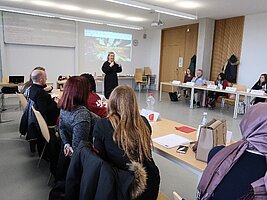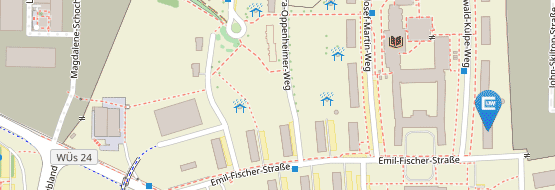Dialogical Assessment & Feedback



Aim of the method/strategy
- The aim is to provide higher education students with an opportunity to learn by engaging and working together through continuous dialogue and feedforward (versus feedback).
Setting
- Flat rooms are preferred over tiered in order to stimulate dialogical, team-focussed discussion.
Type and name of the course, curriculum, number of students
- Assessment and Feedback Module (thematic area - Further Adult and Continuing Education). This is a 12-week module, it is part of a BSc (Hons) in Education & Training (Level 6 EQF).
- Typical number of students: day time programme – 60, evening programme – 30-40.
- In the end of the module students produce a report on assessment design consisting (among other parts) of rationale, theories of assessment and a rubric developed by the student.
Description of method/strategy
For this particular module, the timeline consists of:
- Introduction - explanation that this is an adult model of learning, ‘psychological contract’ with students, learning how lecturer works, other instructions and housekeeping matters. As this method largely depends on student interaction in class, incentives for attendance are introduced (e.g. extra 10% for attending all sessions; 20% of module for reflection on article discussed in class only).
- Core part of the module comprising:
(a) Coming to a shared understanding of terms and criteria, e.g. what rubric is and what marking is. Students collectively develop design a rubric for ‘what is a good cookie’, develop criteria for marking, agreed standards.
(b) During the next class, use the jointly developed rubric for ‘what is a good cookie’ to mark several brands of cookies brought to class by the lecturer (some can be homemade!).
(c) Several rounds of marking anonymised assignments from past students (with appropriate permissions in place) done in groups of not more than 5 people; Students are presented with assignments of varying quality, previously marked as good, medium or poor. Through marking, students’ attention is drawn to particular areas where difficulties in their own work may arise (e.g. referencing). Giving feedback on somebody else’s assignment from previous years can teach how to do the assignment. Lecturer evaluates marking and feedback of student assessor. Peer assessment is also utilised.
(d) Around week 8, evaluation quiz is done during class without prior preparation (e.g. using Socrative https://socrative.com/), to assess how much students know about curriculum design. Iterative assessment is done to estimate what the students have learned, and curriculum gets re-designed based on results.
- (3) Last session of the module is an open tutorial, students can ask lecturer about their own assignment. Students design their own assignment.
Materials required
- Projector screen to show materials for discussion; store-purchased and baked cookies; an app for conducting evaluation quiz (e.g. Socrative https://socrative.com/)
Origin and theoretical framework
- This method is based on the constructivist theory of knowledge ‘on the premise that meaning cannot be imposed or transmitted by direct teaching but created by the students through their learning activities (Biggs and Tang, 1998 in Rami and Lorenzi, 2012b). Thus, this method builds upon ‘prior knowledge and understanding how to construct new knowledge from authentic experiences’ (Rami and Lorenzi, 2012b). Furthermore, according to Dewey (1938), ‘Knowledge emerges only from situations in which learners have to draw it out of meaningful experiences’ (in Rami and Lorenzi, 2012a).
- The Dialogical assessment and feedback method is based on a dialogical model for assessment and evaluation (see Figure 1) developed as a result of research by Rami and Lorenzi (2012a). The idea behind this method is to conduct assessment for learning rather than assessment of learning. Teaching quality is measured and judged by students’ feedback, and learning is viewed as more important than teaching.
- Freyre’s influence reflecting on objectivity (e.g. what does ‘discuss’ mean when rubric asks ‘to discuss’?).
Risks and advantages
This method uses formative assessment which can be easier to set up than summative assessment but harder to assess. Summative assessments are often done in the form of exams which may be easier to mark. Furthermore, in formative assessment objective use of terms is important (e.g. what does it mean ‘to discuss’ in the rubric?).
Advantages:
- Advantages include experiential learning different from a traditional approach, incorporated elements of fun (cookies), potential for increased memory retention. This approach to assessment opens Pandora’s box of assessment, it allows to establish clear criteria how to make it objective, facilitating shared understanding between lecturer and students. Formative feedback gives students an idea where they are early in the process, which provides an opportunity for reflection to understand the criteria and adjust expectations.
Risks:
- This is a 10-credit module in DCU allowing for more workload than a standard module. Dialogical assessment and feedback method requires a different level and type of engagement, therefore carrying potential risk for high student workload. Higher workload for the educator can also be expected as this method requires careful planning; teaching and marking can require more time commitment. If cookies analogy is used, consideration needs to be given to individuals with food intolerance or allergies.
Possible variations
- Student essays in different contexts
Other examples where you think it could be used
- Can be used in any module, but takes planning.
Recommendations
- Assignments don’t need to be very heavy, rich learning happens during the process.
- This method is focused on keeping dialogue all the time, using feedforward versus feedback. However, this process requires attendance and conversation, students have to prepare. Engaging students can help increase their attendance.
- In this particular module on assessment, it is important to try and change the perception of assessment as something negative that some learners can carry from early years.
Contact Person
Justin Rami (justin.rami@dcu.ie)


